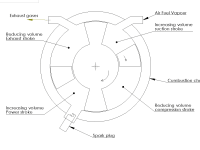This Rotary Engine consists of a cylindrical combustion chamber which contains 2 cross partitions in the form of X dividing the cylindrical chamber in 4 compartments. Extension of one partition serves as an output shaft and the other partition oscillates relative to the former while both rotating together. The partitions are externally connected through a mechanism which regulates the relative oscillating motion. This relative movement of partitions cause the 4 compartments in opposite pairs to undergo reduction & enlargement in their volumes respectively . The compartments undergoing reduction in volume can be considered respective compression & exhaust strokes . At the same time other pair of compartments undergoing increase in volume can be considered as suction & power ( expansion ) strokes respectively.
The compartment undergoing increase in volume is provided with an opening in the chamber to allow the air enter the compartment ( suction stroke ). The adjacent compartment undergoing reduction in volume causes to expel air ( exhaust stroke ) through another opening . One opening is provided at a suitable place where maximum compression occurs .Here a spark plug is fitted to initiate firing & cause expansion stroke. This is as shown in the attached sketch. When the compartments rotate , it can be observed that at a time all the 4 strokes of the cycle are occurring in succession & thus in one complete rotation it will give 4 power strokes. In comparison with standard single cylinder 4 stroke engine, where one power stroke occurs in 2 shaft rotations, this rotary engine will give 8 power strokes in same no. of rotations. Hence for the same engine power rating, this engine will give very smooth torque , nearly as average torque without heavy peaks or fluctuations.
The construction of engine parts is very compact , light weight , symmetrical about axis, without any reciprocating parts or eccentric wobbling parts. There no camshaft or valve gear mechanism. The compartments are to be made air tight from each other & from enclosing side walls of engine by using wiper seals. A working prototype was made with the outer & inner diameters as 100 & 50 mm. 4 sectors were assembled in the annular space to constitute partitions and fitted as pairs of opposite sectors. The compression pressure of 7 bar was achieved sufficient to run on petrol fuel with carburetor. The engine was completed with 4 point Lucas distributor connected to out put shaft, battery & wiring to spark plug. The engine was cranked & could be run several minutes. The prototype was made to prove the concept. There was no cooling system , lubrication etc. incorporated due to cost.
Being rotary without reciprocating parts, the output power will be vibration free as there is no wobbling / eccentrically rotating part & without pulsating exhaust as the exhaust is a almost continuous flow. Further if the dimensions of the engine are made twice, the out put power would be eight times more.
Voting
-
ABOUT THE ENTRANT
- Name:Vasant Bhide
- Type of entry:individual
- Number of times previously entering contest:3
- Vasant is inspired by:To improve the existing design to simplify manufacture.
- Patent status:none





